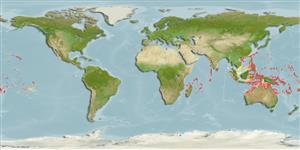Environment / Climate / Range
Ecology
Marine; reef-associated; depth range 8 - 42 m (Ref. 1602), usually 30 - ? m. Tropical, preferred ?; 28°N - 24°S
Indo-Pacific: East Africa to the Hawaiian and Society islands, south to the Great Barrier Reef; Pohnpei and Marshall Islands in Micronesia.
Size / Weight / Age
Maturity: Lm ? range ? - ? cm
Max length : 6.0 cm TL male/unsexed; (Ref. 9710)
Dorsal
spines
(total): 9;
Dorsal
soft rays
(total): 10-11;
Anal
spines: 3;
Anal
soft rays: 8;
Vertebrae: 23. Closely resembles juveniles of Cheilinus fasciatus and Epibulus insidiator. Since they have broadly overlapping meristics, color pattern is the only reliable distinguishing character (Ref. 1602). Body of adults when fresh grayish brown, becoming reddish brown on mid side and ventrally on some specimens. Head with narrow, diagonal pale bands radiating from the orbit; iris bluish with reddish inner rim and an upper and lower streak of pale yellow. A large black spot covering more than half of pelvic fin. One predorsal bone. Premaxilla protractile. Spinous portions of dorsal and anal fins deeply incised.
Inhabit caves or crevices of lagoon and seaward reefs and drop-offs (Ref. 37816). Benthic and benthopelagic (Ref. 58302). Specimens usually taken at depths of at least 30 m. Secretive (Ref. 37816).
Life cycle and mating behavior
Maturity | Reproduction | Spawning | Eggs | Fecundity | Larvae
Oviparous, distinct pairing during breeding (Ref. 205).
Randall, J.E., 1983. Revision of the Indo-Pacific labrid fish genus Wetmorella. Copeia 1983(4):875-883. (Ref. 2138)
IUCN Red List Status (Ref. 115185)
CITES (Ref. 94142)
Not Evaluated
Threat to humans
Harmless
Human uses
More information
ReferencesAquacultureAquaculture profileStrainsGeneticsAllele frequenciesHeritabilityDiseasesProcessingMass conversion
Tools
Special reports
Download XML
Internet sources
Estimates of some properties based on models
Phylogenetic diversity index (Ref.
82805): PD
50 = 0.6250 [Uniqueness, from 0.5 = low to 2.0 = high].
Bayesian length-weight: a=0.02042 (0.00821 - 0.05081), b=2.99 (2.78 - 3.20), in cm Total Length, based on LWR estimates for this (Sub)family-body shape (Ref.
93245).
Trophic Level (Ref.
69278): 3.3 ±0.5 se; Based on size and trophs of closest relatives
Resilience (Ref.
69278): High, minimum population doubling time less than 15 months (Preliminary K or Fecundity.).
Vulnerability (Ref.
59153): Low vulnerability (11 of 100) .
